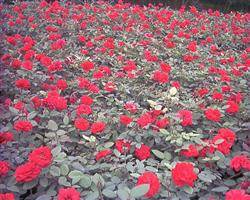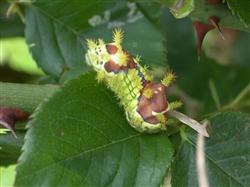How to fertilize and manage rose planting?

How to fertilize and manage rose planting? Please give guidance to rose fertilization varies from season to season, 25% in summer and 12.5% in winter. All kinds of chemical fertilizers of nitrate nitrogen and ammonium nitrogen can be used, but urea should not be used, especially in clay soil, because urea will increase the pH value of the soil. There are two kinds of rose fertilization: root fertilization and extra-root topdressing. When finishing the bed, the base fertilizer can be fully applied, and there can be less fertilization or no fertilization in the early stage. The ratio of nitrogen to phosphorus to potassium for rose is 1:1:2 or 1:1:3. The principle of diligent application of thin fertilizer should be grasped in fertilization. The concentration of extra-root topdressing is not more than 0.3%. When applying fertilizer, we should pay attention to the following situations: fertilizing after anthesis to ensure the nutrients needed for the next flowering; applying more phosphorus and potash fertilizer and less nitrogen fertilizer after autumn; applying fertilizer before and after pruning; spraying outside the root should be uniform and thoughtful. Do not spray on rainy or cloudy days, preferably in the morning when there is no wind in sunny days. The commonly used chemical fertilizer formula is: urea 1kg, calcium superphosphate 2kg, potassium sulfate 2kg mixed and applied in time, 40g per plant. Or urea 1.1kg, calcium 3.17kg, potassium sulfate 3.17kg, magnesium sulfate 0.45kg mixed, immediately use, should not be stored for a long time, the dosage of 28g per plant. Fertilization time and method: fertilization is usually carried out a few days after irrigation, when the soil is not too dry or too wet, and the fertilizer is spread evenly around the plants other than the stem 20~25cm. If the plant density is high, strip application can also be adopted, that is, sprinkling it between the rows of the plant, then shallow ploughing and loosening the soil, and irrigation to help fertilizer dissolve and permeate. Fertilizers are often added after flowering in the previous crop to promote new buds in the plant. Or in the early spring when the soil temperature is low, the microbial activity is poor, and the release of organic fertilizer is slow, so as to promote the flower bud to sprout as soon as possible in spring. It is also applied after pruning or when the plant is short of fertilizer. Chemical fertilizer can also be dissolved in water into liquid fertilizer application, but must pay attention to the application concentration, the ratio of total fertilizer to water is 1/1000 or 2/1000, too high concentration is easy to damage the root system and cause adverse consequences. Foliar fertilization: foliar fertilization is an auxiliary measure of fertilizer supply, which can not completely replace soil fertilization. As foliar fertilization uses less fertilizer and achieves quick results, fertilizer flows into the sap after a few hours of use, which is especially suitable for targeted application when the rose lacks certain elements, so it has been accepted by most producers. Fertilizer collocation: can be mixed according to the needs of the rose, or can be used alone. The most commonly used coordination methods are: urea 1.25g, potassium dihydrogen phosphate 1.25g, water, the complete fertilizer of nitrogen, phosphorus and potassium, the concentration is 2.5 parts per thousand. The other formula is: urea 112.7g, potassium sulfate 112.7g, magnesium sulfate 56.3g, ferric sulfate 28.2g, water 284.3L, the concentration is 1.25 parts per thousand. The formula for correcting the deficiency of trace elements: manganese sulfate 15g, magnesium sulfate 20g, iron chelate 10g, boric acid 5g, water 25L, the concentration is 2/1000. Foliar fertilization time and method: the solution concentration should be controlled at about 2/1000, high concentration is easy to damage the leaves; do not apply when the leaves are too young, because it does not have the ability to absorb nutrients. Both sides of the leaves should be thoroughly wet; do not spray before and after rain; spray in the morning when there is no strong wind; do not spray in high temperature and sunny days; spray with spray nozzles; urea can be mixed with some insecticides against diseases and insect pests. Other fertilizers can also be mixed with agents against diseases and insect pests. In order to improve the effectiveness of foliar fertilization, the developing agent can be added to the sprayed liquid, if not, neutral soap or washing powder can be used, add appropriate amount to the liquid to stir out foam and spray. Spray when the leaves show symptoms of fertilizer deficiency, once every 7 to 10 days, until the symptoms of fertilizer deficiency disappear. General principles of the fertilization cycle of rose: before the cultivation of rose, a large amount of organic fertilizer and appropriate amount of phosphate fertilizer should be added; at the initial stage of rose planting, an appropriate amount of urea should be applied to promote its early development; after pruning and during the period of active growth of rose, fertilizer should be applied frequently. Click to get more rose planting techniques click to get more flower planting techniques
- Prev

How to plant Chinese rose?
How to plant Chinese rose? Please introduce in detail and guide the planting method of rose can refer to the following: wild rose or special rootstock used for grafting propagation as rootstock, grafting or budding method is used for grafting. The rootstocks were sown at the beginning of April of the first year and transplanted in April of the following year. The seedbed should choose rich and loose sandy soil.
- Next

What is the Chinese rose leafhopper?
How to control Spodoptera litura? Please guide the rose yellow moth: morphological features: adults orange-yellow, antennae filamentous brown diagonal, converging at the tip of the wing. It is inverted v-shaped, the hind wings are grayish yellow, the feet are brown, the eggs are flat and oval, yellowish. The larva is slightly rectangular, the front end is slightly larger, and the body color.
Related
- Fuxing push coffee new agricultural production and marketing class: lack of small-scale processing plants
- Jujube rice field leisure farm deep ploughing Yilan for five years to create a space for organic food and play
- Nongyu Farm-A trial of organic papaya for brave women with advanced technology
- Four points for attention in the prevention and control of diseases and insect pests of edible fungi
- How to add nutrient solution to Edible Fungi
- Is there any good way to control edible fungus mites?
- Open Inoculation Technology of Edible Fungi
- Is there any clever way to use fertilizer for edible fungus in winter?
- What agents are used to kill the pathogens of edible fungi in the mushroom shed?
- Rapid drying of Edible Fungi

